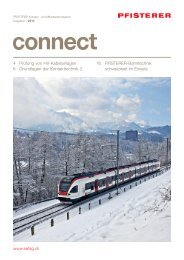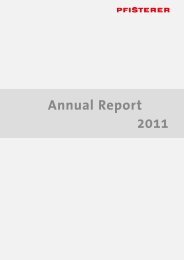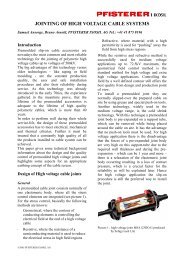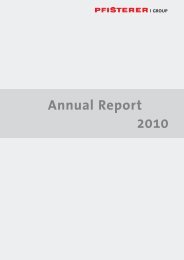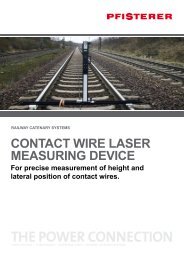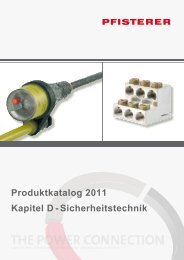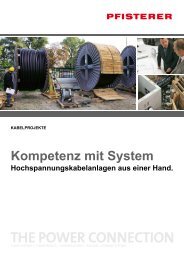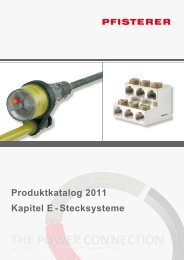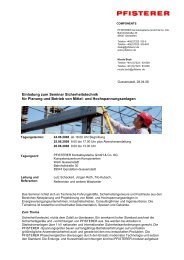El primer sistema de racor de cable con pernos de rotura ... - Pfisterer
El primer sistema de racor de cable con pernos de rotura ... - Pfisterer
El primer sistema de racor de cable con pernos de rotura ... - Pfisterer
You also want an ePaper? Increase the reach of your titles
YUMPU automatically turns print PDFs into web optimized ePapers that Google loves.
REDES DE BAjA y mEDIA TENSIóN<br />
SICON<br />
<strong>El</strong> <strong>primer</strong> <strong>sistema</strong> <strong>de</strong> <strong>racor</strong> <strong>de</strong> <strong>cable</strong> <strong>con</strong><br />
<strong>pernos</strong> <strong>de</strong> <strong>rotura</strong> <strong>de</strong> progresión <strong>con</strong>tinua.
Lo mejor es el enemigo <strong>de</strong> lo bueno.<br />
Hace varios años que los bornes, <strong>racor</strong>es y terminales<br />
<strong>de</strong> <strong>cable</strong> <strong>con</strong> técnica <strong>de</strong> atornillado están extendiéndose.<br />
Con razón. Los <strong>racor</strong>es atornillados ofrecen ventajas<br />
técnicas y prácticas, que no pue<strong>de</strong>n aportar los <strong>racor</strong>es<br />
a presión. Como por ejemplo un amplio rango <strong>de</strong> sección<br />
y una manipulación sencilla. Esta técnica <strong>de</strong> fijación se<br />
a<strong>de</strong>cua perfectamente a los nuevos juegos <strong>de</strong> <strong>cable</strong>s multitensiones.<br />
<strong>El</strong> montaje se realiza <strong>con</strong> herramientas muy<br />
sencillas literalmente en un abrir y cerrar <strong>de</strong> ojos.<br />
<strong>El</strong> estado ancestral <strong>de</strong> la técnica <strong>de</strong> atornillado se<br />
llamaba "perno <strong>de</strong> <strong>rotura</strong> <strong>de</strong> niveles múltiples". <strong>El</strong><br />
punto fuerte <strong>de</strong> la <strong>con</strong>strucción <strong>de</strong> los <strong>pernos</strong> <strong>de</strong> <strong>rotura</strong> <strong>de</strong><br />
niveles múltiples, a saber los sitios <strong>de</strong> <strong>rotura</strong> <strong>con</strong>trolada,<br />
al mismo tiempo es su punto débil <strong>de</strong>cisivo. Cada sitio<br />
<strong>de</strong> <strong>rotura</strong> interrumpe la rosca portante, no pudiéndose<br />
movilizar la máxima fuerza <strong>de</strong> sujeción. Otra <strong>de</strong>sventaja:<br />
los niveles <strong>de</strong>ben estar muy bien adaptados a los <strong>con</strong>ductores<br />
colocados, ya que si no el perno se rompe más<br />
abajo o arriba.<br />
La novedad <strong>de</strong> PFISTERER: <strong>pernos</strong> <strong>de</strong> <strong>rotura</strong> <strong>de</strong><br />
progresión <strong>con</strong>tinua. La particularidad <strong>de</strong> la <strong>con</strong>strucción<br />
es que no presentan puntos <strong>de</strong> <strong>rotura</strong> <strong>con</strong>trolada en la<br />
rosca. Con ello se garantiza la capacidad <strong>de</strong> carga óptima<br />
<strong>de</strong> la rosca para cualquier rango <strong>de</strong> sección. <strong>El</strong> punto <strong>de</strong><br />
<strong>rotura</strong> <strong>de</strong>l perno siempre se encuentra en la superficie <strong>de</strong>l<br />
cuerpo <strong>de</strong> apriete ya no sobresale nada, no hay que limar<br />
salientes para que el manguito se ajuste.<br />
Ventajas<br />
n Hasta un 30% más <strong>de</strong> fuerza <strong>de</strong> <strong>con</strong>tacto<br />
que los bornes <strong>con</strong>vencionales<br />
n Tornillos <strong>de</strong> platillo <strong>con</strong> prisioneros para lograr una<br />
fricción uniforme y una fuerza <strong>de</strong> <strong>con</strong>tacto superior<br />
n Nada sobresale, ya no es necesario limar<br />
n Pleno aprovechamiento <strong>de</strong> la capacidad <strong>de</strong> carga<br />
<strong>de</strong> la rosca <strong>con</strong> cualquier diámetro <strong>de</strong> <strong>con</strong>ductor<br />
n No se requieren herramientas especiales<br />
n <strong>El</strong> corte suave por cizalladura <strong>de</strong> los <strong>pernos</strong> <strong>de</strong><br />
<strong>rotura</strong> facilita el apretado<br />
n Los restos <strong>de</strong>l perno permanecen en la<br />
herramienta y pue<strong>de</strong>n eliminarse <strong>con</strong> seguridad<br />
n También a<strong>de</strong>cuado para <strong>cable</strong>s <strong>de</strong> hilo fino <strong>de</strong><br />
la clase 5
SICON – el <strong>primer</strong><br />
perno <strong>de</strong> <strong>rotura</strong> <strong>con</strong>tinua.<br />
1<br />
2<br />
3<br />
1<br />
2 4<br />
UnallaveAllenestándaractúasobreuntornilloprisionero,<br />
que se atornilla en el taladro <strong>de</strong>l perno <strong>de</strong> presión <strong>de</strong><br />
progresión <strong>con</strong>tinua. La adherencia no se interrumpe<br />
por ningún tipo <strong>de</strong> niveles o entalladuras en el perno.<br />
Al fijar el perno SICON, se suelta el el plato <strong>de</strong><br />
presión en la parte inferior <strong>de</strong> dicho perno. <strong>El</strong> perno<br />
gira sobre el plato y, al <strong>con</strong>trario <strong>de</strong> lo que ocurre<br />
<strong>con</strong> los <strong>pernos</strong> <strong>con</strong>vencionales, no se produce ninguna<br />
fricción <strong>de</strong> cabeza en el <strong>con</strong>ductor. <strong>El</strong> par <strong>de</strong>l<br />
perno genera la presión <strong>de</strong> <strong>con</strong>tacto casi in<strong>de</strong>pendientemente<br />
<strong>de</strong>l material <strong>de</strong>l <strong>con</strong>ductor. De este modo,<br />
los <strong>con</strong>ductores <strong>de</strong> aluminio alcanzan una presión<br />
<strong>de</strong> <strong>con</strong>tacto notablemente superior y los <strong>con</strong>ductores<br />
<strong>de</strong> hilo fino no se dañan.<br />
<strong>El</strong> perno SICON sigue girando hasta alcanzar el par<br />
<strong>de</strong> <strong>rotura</strong>. Es sometido a esfuerzo por tracción al<br />
atornillarse, siendo expandido <strong>de</strong> forma axial al<br />
alcanzar el par <strong>de</strong> <strong>rotura</strong>, <strong>de</strong>sgarrándose en <strong>con</strong>secuencia.<br />
En comparación <strong>con</strong> los <strong>pernos</strong> <strong>de</strong> <strong>rotura</strong><br />
<strong>con</strong>vencionales, éste se <strong>de</strong>sgarra <strong>de</strong> forma suave y<br />
casi sin sacudida.<br />
3<br />
4<br />
<strong>El</strong> perno SICON siempre se <strong>de</strong>sgarra directamente<br />
en la superficie <strong>de</strong>l cuerpo <strong>de</strong> apriete. Con ello en<br />
todo momento se <strong>con</strong>sigue el saliente mínimo posible,<br />
in<strong>de</strong>pendientemente <strong>de</strong>l <strong>con</strong>ductor a empalmar.<br />
3
Sin sitios <strong>de</strong> <strong>rotura</strong> <strong>con</strong>trolada,<br />
sin puntos débiles.<br />
Características técnicas<br />
n Amplios rangos <strong>de</strong> sujeción: 10 – 95 mm 2;<br />
25 – 150 mm 2; 50 – 240 mm 2; 95 – 300 mm 2;<br />
185 – 400 mm 2; 300 – 630 mm 2<br />
(otros a petición)<br />
n Canal <strong>de</strong> apriete <strong>con</strong> estriado transversal y<br />
protección antióxido <strong>de</strong>l <strong>con</strong>ductor<br />
n Travesaño <strong>de</strong> separación como barrera al aceite<br />
a prueba <strong>de</strong> presión diseñado para el <strong>cable</strong> <strong>de</strong><br />
puesta a tierra<br />
n Técnica <strong>de</strong> <strong>con</strong>tacto eléctrica y mecánica<br />
homologada <strong>con</strong>forme <strong>con</strong> IEC 61238-1<br />
n Forma compacta: cantos redon<strong>de</strong>ados y<br />
transiciones aplanadas, a<strong>de</strong>cuados para<br />
técnicas <strong>de</strong> casquillos <strong>de</strong> <strong>de</strong>slizamiento<br />
y <strong>de</strong> <strong>con</strong>tracción<br />
n A<strong>de</strong>cuado para <strong>con</strong>ductores <strong>de</strong> cobre<br />
y aluminio<br />
n Es posible un guiado central <strong>de</strong>l <strong>con</strong>ductor<br />
<strong>con</strong> diferentes casquillos <strong>de</strong> centraje
Datos técnicos.<br />
Racor atornillado <strong>con</strong> <strong>de</strong>rivación<br />
Racor pasante <strong>con</strong> tabique<br />
Terminales <strong>de</strong> <strong>cable</strong> atornillados<br />
Accesorios<br />
Nº mm 2 mm 2 mm 2 mm 2 mm 2 Orificio Ancho <strong>de</strong> Número L1 DØ dØ<br />
(Al + Cu) <strong>de</strong> brida llave (SW) <strong>de</strong> tornillos mm mm mm<br />
332 447 010 50 – 240 50 – 185 50 – 185 50 – 150 50 – 240 – SW 6 6 162 68/33 20<br />
332 601 010 10 – 95 10 – 95 50 – 95 35 – 70 10 – 95 – SW 5 2 65 24 13<br />
332 607 010 25 – 150 25 – 150 35 – 120 35 – 120 25 – 150 – SW 5 2 68 28 16,3<br />
332 593 010 25 – 150 25 – 150 35 – 120 35 – 120 25 – 150 – SW 5 4 102 28 16,3<br />
332 592 010 50 – 240 50 – 185 50 – 185 50 – 150 50 – 240 – SW 6 4 126 33 20<br />
332 614 010 50 – 240 50 – 240 50 – 240 50 – 240 50 – 240 – SW 6 4 126 35 21<br />
332 602 010 95 – 400 95 – 300 95 – 240 95 – 240 95 – 300 – SW 8 4 140 38 24<br />
332 617 010 185 – 500 185 – 400 185 – 240 185 – 240 185 – 400 – SW 8 6 170 42 26<br />
332 603 010 300 – 800 300 – 630 – 300 – 400 300 – 630 – SW 8 6 230 52 33,3<br />
332 604 010 10 – 95 10 – 95 50 – 95 35 – 70 10 – 95 13 SW 5 1 70 24 13<br />
332 599 010 25 – 150 25 – 150 35 – 120 35 – 120 25 – 150 13 SW 5 2 91 28 16,3<br />
332 595 010 50 – 240 50 – 185 50 – 185 50 – 150 50 – 240 13 SW 6 2 115 33 20<br />
332 595 011 50 – 240 50 – 185 50 – 185 50 – 150 50 – 240 16,5 SW 6 2 115 33 20<br />
332 605 010 95 – 400 95 – 300 95 – 240 95 – 240 95 – 300 13 SW 8 2 120 38 24<br />
332 605 011 95 – 400 95 – 300 95 – 240 95 – 240 95 – 300 16,5 SW 8 2 120 38 24<br />
332 625 010 185 – 500 185 – 400 185 – 240 185 – 240 185 – 400 13 SW 8 3 138 42 26<br />
332 625 011 185 – 500 185 – 400 185 – 240 185 – 240 185 – 400 16,5 SW 8 3 138 42 26<br />
332 606 010 300 – 800 300 – 630 – 300 – 400 300 – 630 16,5 SW 8 3 180 50 33,3<br />
Terminales <strong>de</strong> <strong>cable</strong> atornillados axiales a petición.<br />
305 917 001 Llave <strong>de</strong> impacto <strong>de</strong> batería para facilitar el montaje <strong>de</strong> <strong>racor</strong>es y terminales <strong>de</strong> <strong>cable</strong> atornillados; el suministro<br />
incluye una batería <strong>de</strong>recambio, un cargador, un juego <strong>de</strong> herramientas (llave hexagonal tamaño 5, 6 y 8, llave<br />
tamaño 8, 10, 13, 16 y 19)<br />
305 917 106 Hexágono interior <strong>de</strong> recambio, utilizado para la llave <strong>de</strong> impacto <strong>de</strong> batería 1/2", ancho <strong>de</strong> llave 6 y longitud<br />
<strong>de</strong> punta 9 mm<br />
305 917 107 Hexágono interior <strong>de</strong> recambio, utilizado para la llave <strong>de</strong> impacto <strong>de</strong> batería 1/2", ancho <strong>de</strong> llave 6 y longitud<br />
<strong>de</strong> punta 19 mm<br />
331 901 900 Contrasoporte para <strong>racor</strong> atornillado<br />
Reservado el <strong>de</strong>recho a modificaciones técnicas. Se pue<strong>de</strong>n obtener otros mo<strong>de</strong>los a petición.
PFISTERER en el mundo<br />
042<br />
PFISTERER<br />
PFISTERER UPRESA S.A.U.<br />
PFISTERER<br />
Kontaktsysteme GmbH & Co. KG Calle Industria 90-92<br />
Oficina <strong>de</strong> representación<br />
Bahnhofstraße 30<br />
08025 Barcelona<br />
132 Tanjong Rhu Road<br />
89547 Gerstetten-Gussenstadt<br />
España<br />
03 - 12 Pebble Bay<br />
Alemania<br />
Teléfono +34 (0) 93 4367409<br />
Singapore 436919<br />
Teléfono +49 (0)73 23 / 83 - 0<br />
Telefax +34 (0) 93 4367701<br />
Singapur<br />
Telefax +49 (0) (0)73 23 / 83 - 603 pfisterer.upresa@pfistererupresa.eu Teléfono +65 6346 4042<br />
E-Mail dialog@pfisterer.<strong>de</strong><br />
Telefax +65 6346 7110<br />
PFISTERER Sàrl.<br />
E-Mail info@pfisterer.sg<br />
35 avenue d\u2019Italie<br />
BP 10045<br />
PFISTERER (Pty.) Ltd.<br />
PFISTERER S.A.<br />
68311 lllzach Ce<strong>de</strong>x<br />
9 Willowton Road<br />
Av. Velez Sarsfield 464<br />
Francia<br />
Pietermaritzburg 3201<br />
C1282AFR Buenos Aires<br />
Teléfono +33 (0) 389 319029<br />
Sudáfrica<br />
Argentina<br />
Telefax +33 (0) 389 319028<br />
Teléfono +27 (0) 33 397 5400<br />
Teléfono +54 (0) 11 4306 3595<br />
E-Mail info@pfisterer.fr<br />
Telefax +27 (0) 33 387 6377<br />
Telefax +54 (0) 11 4362 2381<br />
E-Mail info@pfisterer.co.za<br />
E-Mail pfisterer@pfisterer.com.ar<br />
PFISTERER Ltd.<br />
29 Pillings Road<br />
PFISTERER AB<br />
PFISTERER Ges.m.b.H.<br />
Oakham LE15 6QF<br />
Flygfältsgatan 2<br />
Augasse 17<br />
Gran Bretaña<br />
12822 Skarpnäck<br />
1090 Viena<br />
Teléfono +44 (0) 15 7277 1300 Suecia<br />
Austria<br />
Telefax +44 (0) 15 7277 1269<br />
Teléfono +46 (0) 8 7240 150<br />
Teléfono +43 (0) 1 3176531 0<br />
E-Mail info.uk@pfisterer.com<br />
Telefax +46 (0) 8 6054 750<br />
Telefax +43 (0) 1 3176531 12<br />
E-Mail info.se@pfisterer.com<br />
E-Mail info@pfisterer.at<br />
PFISTERER Kereske<strong>de</strong>lmi Kft.<br />
Gyarmat u. 67/C<br />
PFISTERER SEFAG AG<br />
PFISTERER<br />
1147 Budapest<br />
Werkstraße 7<br />
Oficina <strong>de</strong> representación<br />
Hungría<br />
6102 Malters, Lucerna<br />
Unit 520, Landmark Tower 2<br />
Teléfono +36 (0) 1 2513441<br />
Suiza<br />
8 North Dongsanhuan Road<br />
Telefax +36 (0) 1 2511713<br />
Teléfono +41 (0) 41 4997 272<br />
Chaoyang District<br />
E-Mail office@pfisterer.hu<br />
Telefax +41 (0) 41 4972 269<br />
Beijing 100004<br />
E-Mail <strong>con</strong>nect@sefag.ch<br />
China<br />
PFISTERER s.r.l.<br />
Teléfono +86 10 6590 6272<br />
Via Sirtori 45 d<br />
PFISTERER INTERNATIONAL AG<br />
Telefax +86 10 6590 6105<br />
20017 Passirana di Rho (MI)<br />
Werkstraße 7<br />
E-Mail info.cn@pfisterer.com<br />
Italia<br />
6102 Malters, Lucerna<br />
Teléfono +39 02 93158 11<br />
Suiza<br />
PFISTERER<br />
Telefax +39 02 93158 27<br />
Teléfono +41 (0) 41 4997 474<br />
Oficina <strong>de</strong> representación<br />
E-Mail pfisterer@pfisterer.it<br />
Telefax +41 (0) 41 4973 473<br />
Room 2606, 26/F., Paul Y. Centre<br />
E-Mail export@sefag.ch<br />
51 Hung To Road<br />
PFISTERER Sp. z o.o.<br />
Kwun Tong, Kowloon<br />
Ul. Poznanska 258<br />
Hong kong, China<br />
05-850 Ozarów Mazowiecki<br />
Teléfono +852 2687 2826<br />
Polonia<br />
Telefax +852 2688 0663<br />
Teléfono +48 (0) 22 72241 68<br />
E-Mail info.hk@pfisterer.com<br />
Telefax +48 (0) 22 72127 81<br />
E-Mail info@pfisterer.pl<br />
PFISTERER INTERNATIONAL AG<br />
Oficina <strong>de</strong> representación<br />
PFISTERER<br />
PO Box 184090<br />
Oficina <strong>de</strong> representación<br />
Gate 7, Floor 3<br />
17. listopadu .p. 342<br />
Hamarain Center<br />
Zelené P edm stí<br />
Dubai<br />
530 02 Pardubice<br />
Emiratos Árabes Unidos<br />
República Checa<br />
Teléfono +971 4 2690147<br />
Teléfono +420 (0) 466 657490<br />
Telefax +971 4 2690148<br />
Telefax +420 (0) 466 613581<br />
E-Mail info@pfisterer.ae<br />
E-Mail dialog@pfisterer.cz<br />
PFISTERER en el mundo<br />
www.pfisterer.com<br />
www.pfisterer.com 391 162/2,0 (ES) 2008 © 2007 PFISTERER Kontaktsysteme GmbH & Co. KG | www.pfisterer.com Concepción y diseño: VISCHER & BERNET Stuttgart técnicas<br />
modificaciones o impresión <strong>de</strong> errores <strong>de</strong> caso en responsabilidad admite se No



